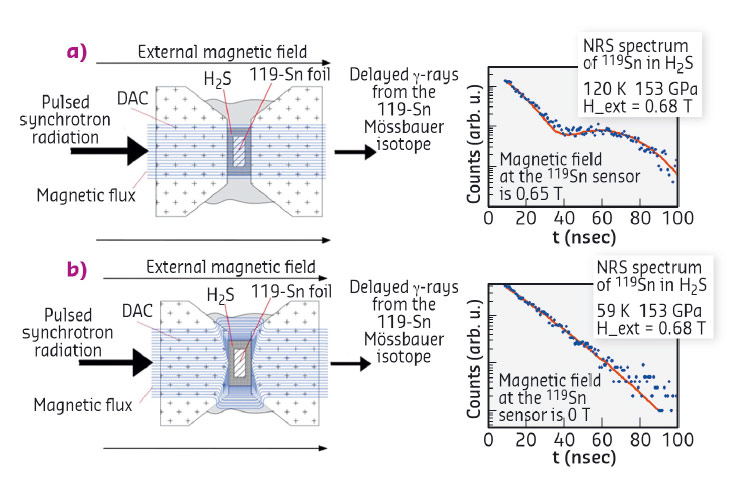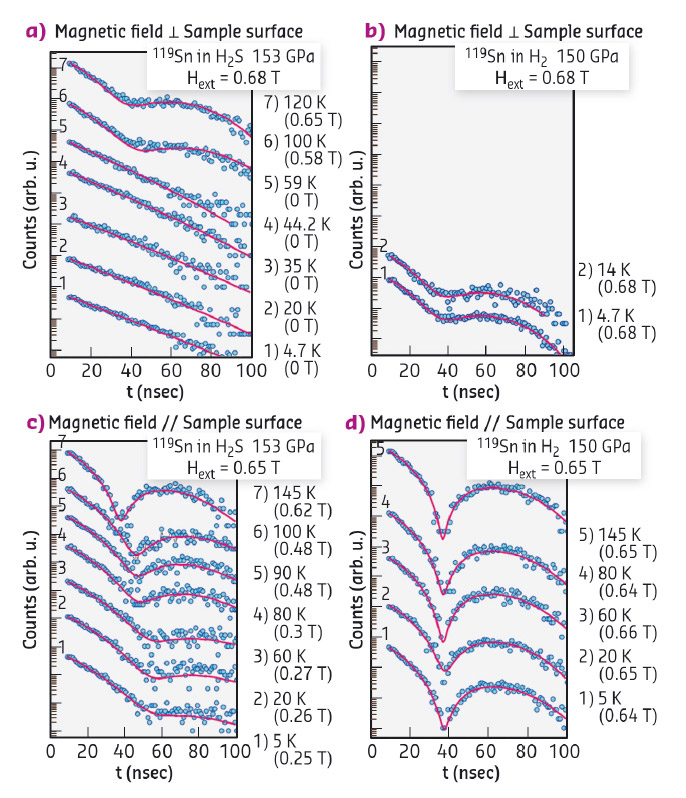- Home
- Users & Science
- Scientific Documentation
- ESRF Highlights
- ESRF Highlights 2016
- Matter at extremes
- Observation of superconductivity in H2S by nuclear resonant scattering
Observation of superconductivity in H2S by nuclear resonant scattering
Synchrotron Mössbauer spectroscopy at the ESRF was used to prove the superconducting nature of a material created inside a high pressure cell. The shielding of the magnetic field by superconducting hydrogen sulfide at 150 GPa was monitored using 119Sn as a sensor.
Recent resistivity and magnetic susceptibility measurements indicated that a superconducting transition occurs in H2S compressed to 150-190 GPa with a high onset temperature of 203 K [1]. For an unambiguous identification of the superconducting state, a direct observation of the Meissner effect in an external magnetic field is desirable. However, the small size of the sample, contained within a diamond-anvil high-pressure cell (DAC), is the main problem for the study of the superconducting properties of samples at such high pressures.
We have developed a new method to follow the shielding of the magnetic flux by a superconducting sample at high pressure by employing nuclear resonance scattering (NRS) at beamline ID18 [2]. A thin foil of tin enriched with the 119Sn isotope to 95% is immersed in the superconductor sample and is used as the sensor of the external magnetic field. The sensor monitors the magnetic field via the magnetic interaction at the 119Sn nucleus using NRS which ensures that we acquire data only from the 119Sn sensor.
 |
|
Fig. 140: Layout of the experiment. The tin foil, surrounded by compressed hydrogen sulfide, is located in a diamond anvil cell at a pressure of about 153 GPa. Pulsed synchrotron radiation excites the nuclei of the tin Mössbauer isotope 119Sn. The detection system measures the time evolution of radiation emitted by the tin nuclei in the forward direction. |
We used this method to determine the superconducting properties of hydrogen sulfide at 150 GPa. The experimental setup is shown in Figure 140 for an external magnetic field applied perpendicular to the sample. When H2S is not in the superconducting state, or the state has been partially destroyed, the magnetic field penetrates into the sample volume and the 119Sn nuclear ground level spin Ig = 1/2 and exited level with spin Iex = 3/2 are split by the magnetic field producing quantum beats in the time spectra (Figure 140a). In contrast, while H2S is in the superconducting state, the magnetic field does not penetrate to the tin foil, the 119Sn nuclear levels are not split, and the corresponding time spectra show an exponential decay (Figure 140b).
To verify that superconductivity occurs in the H2S sample and not in the sensor 119Sn foil, the measurements were conducted simultaneously with two DACs. One contained the H2S sample and the 119Sn sensor foil, and the other contained the reference 119Sn foil loaded with hydrogen (H2) as a pressure transmitting medium. The sample was cooled in zero magnetic field down to the lowest temperature of 5 K and a magnetic field of about 0.7 T was applied. The NRS spectra were then recorded at each temperature point while the temperature was increased.
 |
|
Fig. 141: Time NRS spectra from 119Sn in H2S at 153 GPa (left panels) and in H2 at 150 GPa (right panels) in an external magnetic field in the horizontal (upper panels) and vertical (bottom panels) field geometry. Symbols (blue) are the experimental data and solid lines (red) are the fits by the MOTIF software. Temperatures of the samples and the values of magnetic fields at the 119Sn nuclear site were obtained from the fits and are shown in parentheses next to the corresponding NRS spectra. |
Figures 141a and b show the results obtained with the external magnetic field of 0.68 T applied along the X-ray beam, i.e., perpendicular to the sample plane. In the range of 4.7-59 K, the NRS spectra show an exponential decay, which demonstrates that the magnetic field is completely expelled from the sensor by the superconducting H2S. At 100 K, quantum beats appear indicating that the external magnetic field starts penetrating into the sensor foil and it then increases gradually above 100 K. However, even for the data point at 120 K, the magnetic field at the sensor still does not reach the value of the external magnetic field (Figure 141a). This demonstrates that partial screening still remains up to at least 120 K. A similar trend was observed when an external magnetic field of 0.65 T was applied vertically, i.e., parallel to the sample plane (Figure 141c and d).
These results demonstrate that the superconducting H2S sample effectively shields the sensor from strong magnetic fields of about 0.7 T up to temperatures of 90-100 K. The proposed method should allow the range of pressure for the study of superconductivity to be expanded up to 300 GPa.
Principal publication and authors
Observation of superconductivity in hydrogen sulfide from nuclear resonant scattering, I. Troyan (a,b), A. Gavriliuk (b,c), R. Rüffer (d), A. Chumakov (d,e), A. Mironovich (c), I. Lyubutin (b), D. Perekalin (f), A.P. Drozdov (a) and M.I. Eremets (a), Science 351, 1303-1306 (2016); doi: 10.1126/science.aac8176.
(a) Max-Planck-Institut für Chemie, Mainz (Germany)
(b) Shubnikov Institute of Crystallography of Russian Academy of Sciences, Moscow (Russia)
(c) Institute for Nuclear Research, Troitsk (Russia)
(d) ESRF
(e) National Research Center “Kurchatov Institute”, Moscow (Russia)
(f) A.N. Nesmeyanov Institute of Organoelement Compounds of Russian Academy of Sciences, Moscow (Russia)
References
[1] A.P. Drozdov et al., Nature 525, 73–76 (2015).
[2] R. Rüffer and A.I. Chumakov, Hyperfine interact. 97-98, 589 (1996).
This work was done with support of The Russian Ministry of Education and Science.



